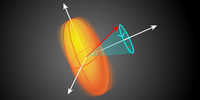The article below was published on February 5, 2020 on APS Physics website, written by Marric Stephens.
Synopsis: Gold Nucleus is Wobbly
A rare kind of nuclear spinning motion has been detected in an isotope of gold.

Planets, footballs, and even some large molecules have something in common: they rotate as rigid, classical bodies. Atomic nuclei are another matter, in that quantum mechanics allows strange new modes of motion. In experiments involving a short-lived isotope of gold, 187Au, Nirupama Sensharma at the University of Notre Dame, Indiana, and colleagues have observed an unusual rotational mode, predicted in 2014, called longitudinal wobbling. Seeing this wobbling mode in such a heavy nucleus puts constraints on theories of nuclear structure.
Like other nuclei with an odd number of nucleons, 187Au can be modeled as a spinning ellipsoid with an independent nucleon orbiting within it. In its ground state, the system rotates smoothly about one of the ellipsoid’s axes. But at higher energies, 187Au, like other ellipsoidal nuclei with three unequal axes, can exhibit a more complex motion. This motion comes from the nucleon tugging on the nucleus, making its rotation axis wobble like an unbalanced spinning top. Alignment between the nucleon’s orbital axis and the nucleus’s long or short dimensions produces transverse wobbling, which has been seen in a handful of nuclei. Sensharma and colleagues’ study provides the first clear detection of longitudinal wobbling, in which the nucleon’s orbital axis aligns with the nucleus’s intermediate-length axis.
The researchers spotted the new mode’s signature in the nuclear debris created by firing fluorine ions at an ytterbium target. Among the isotopes produced in the collision were a host of 187Au nuclei in various excited states. By analyzing the gamma rays emitted as these excited states decayed, the team reconstructed the initial population—including the predicted longitudinal wobbling states. They expect further examples of heavy triaxial nuclei to show up in future studies.
